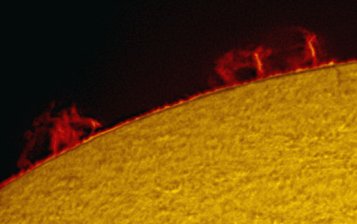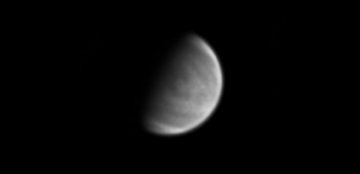 What's the name of that star? Where's Saturn? Get the answers from mySKY--a fun new astronomy helper from Meade.
What's the name of that star? Where's Saturn? Get the answers from mySKY--a fun new astronomy helper from Meade.
SPACE STATION MOVIE: To the naked eye, the International Space Station (ISS) gliding across the night sky appears as a bright point of light. If you turn a backyard telescope on that point, however, it resolves into a sprawling space complex almost as wide as a football field. Ralf Vandebergh of the Netherlands made this movie of the view through his 10-inch telescope on April 19th. Anyone can see the ISS this way; the trick is knowing when to look.
SOLAR ACTIVITY: Today, sunspot 955 is growing rapidly near the center of the sun's disk, but that's not what caught the attention of astrophotographer Jack Newton. Looking through his SolarMax90, he noticed a lively display of prominences along the sun's limb:

"They were gorgeous," he says.
Prominences are clouds of hydrogen held above the sun's surface by magnetic force fields. They can be quite entertaining to watch as they surge and sway like gargantuan flames. Since Newton took his picture, prominences have begun to sprout along the entire expanse of the eastern limb: SOHO image. Stay tuned for more.
HALF-A-PLANET: How many planets does it take to make a bright light in the evening sky? Answer: One-half. See for yourself this evening when Venus beams through the sunset. To the naked eye, Venus is a glaring point of light; through a backyard telescope, it looks like this:

Sean Walker of Chester, New Hampshire, took the picture on May 8th using a 12-inch Newtonian telescope. It shows that Venus, like the Moon, has phases and at the moment Venus is only half full.
His picture also reveals a mystery: dark bands in the planet's global clouds. These bands appear in photos taken through ultraviolet filters. "I used a Baader Venus (UV) filter," says Walker. Some unknown substance within the clouds strongly absorbs UV light, accounting for almost half the solar energy trapped by Venus. Whatever is in there, it plays a big role in maintaining Venus' hellish climate; the average temperature on the surface is about 460° Celsius. Astronomers have been studying the bands since Mariner 10 spotted them in the 1970s, but decades later no one knows the identity of the "UV absorbers." Candidates range from gaseous chlorine and sulfur compounds to alien life using UV radiation as a source of energy. Perhaps Venus Express, a European spacecraft orbiting Venus now, will be able to solve the puzzle.
more images: from Neil Phillips of Crayford, Kent, United Kingdom.

